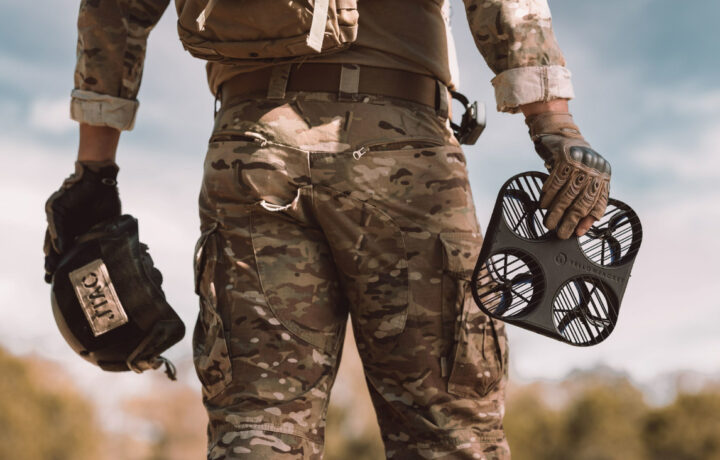At a conference on the future of drone warfare, hosted by the Center for European Policy Analysis (CEPA), this week, defense experts discussed the role unmanned aerial systems (UAS) are playing in current conflicts and addressed the challenges that lay ahead for the United States and its NATO allies.
The United States Navy and its partners have countered drones fired at commercial shipping in the Red Sea, and at targets in Israel; while both Russia and Ukraine have employed a variety of drones on the front lines and beyond in the more than two-year-long war.
Interoperability Remains a Challenge
As NATO has continued to expand, its various member nations already use a wide variety of small arms, armored vehicles, and notably aircraft. While standardization of military hardware has long been a goal for the international military alliance, interoperability among NATO allies remains an issue. The challenge of drones and other unmanned systems isn’t likely to be any easier to find common ground.
“The ability for these various systems to talk with other you know, ideally talk with other systems, so they can collaborate in terms of share target information, for guidance, or share intelligence of targets that they find back to, C2 nodes, command control nodes,” said Gorden B. “Skip” Davis Jr., senior fellow at CEPA, and former NATO deputy assistant secretary general or the Defense Investment Division.
Another issue is that there haven’t even been opportunities to test the interoperability of multiple different systems bringing in the various data. This is slowing the role that artificial intelligence (AI) is playing in the development of autonomous – or even semi-autonomous – drones.
“Therefore the experimentation that we’ve been doing in the background around these technologies, is the technology being fielded isn’t having to be iterated on in the battlefield and see, and that, to me, means we can’t do autonomy yet,” explained Joanne van der Merwe, a non-resident fellow with the Defense Tech Initiative at CEPA. “If we’re still iterating on the battlefield and experimenting on the battlefield right now,” then automation is required for a “high level of predictability with your drones on the battlefield.”
Capability Gap – NATO Lagging Behind
There exists a serious capability gap within NATO, but also with near-peer adversaries. This is increasingly true with autonomous drone platforms, with many NATO nations lagging in terms of aerial drone capabilities, but also in other domains.
“We found in our research was that the Russians are, are doing well, now they’re catching up, but they were behind significantly early on,” said Davis.
“They’re using, as we, as we would expect, you know, their advantages of mass production,” Davis continued. “And, frankly, their ability to, you know, talk with other spoilers, I think Iran and North Korea and of course, China for components to build up their drone capability and use it to effect from the class to showerheads that strike critical infrastructure and civilian infrastructure populations to the Lancet three and the whole series have got it, they got a number of, of class one drones of various sizes.”
The Kremlin has been able to employ their ability to scale, and then move things forward to the battlefield to catch up.
“Hopefully, they will stay outside of the innovation cycle of Ukrainians,” Davis noted. “(Kyiv) lacks the mass that the Russians enjoy. And let’s hope that, you know, additional Western assistance, and continued Ukrainian focus on drones… will help them stay in the main state of fight.”
Drone On – How to Stop Them!
Last year, the United States Army set up a new drone fighting school at Fort Sill, OK, home to the Army Field Artillery School. Instead of training drone operators, the school’s focus is on countering enemy drones – an issue of valid concern noted the CEPA experts on Monday.
Countering UAS remains a major concern for war planners – in part because drones had not been employed in combat in the numbers seen in Ukraine. Small commercial “off-the-shelf” platforms armed with an explosive package have been employed by both sides to target tanks and other vehicles, as well as defensive positions. Loitering munitions, also known as suicide or “kamikaze” drones can seek out targets and then strike with pinpoint accuracy – combining the capabilities of a drone and cruise missile.
Ukrainian soldiers have employed a variety of tactics to counter the drones, including low-tech options that include soldiers armed with heavy gauge shotguns. At the same time, the British Ministry of Defence is exploring directed energy weapons (DEWS) that employ lasers or microwaves to counter aerial threats.
“Despite increased focus and resources, many NATO countries are not well-positioned to counter what is becoming a very vicious and purposeful threat coming from drones,” warned Federico Borsari, Leonardo Fellow with the Transatlantic Defense and Security Program at CEPA.
“The range of systems out there right now from directed energy to, you know, pinpoint targeted to spray like… shotgun(s) and others rapid fire to allow for the rapid movement capability of the of UAS systems are all going to be important,” added Davis. “And given the array of capabilities that the UAS will continue to incorporate, it will require a variety of capabilities and a layered defense for the foreseeable future.”




